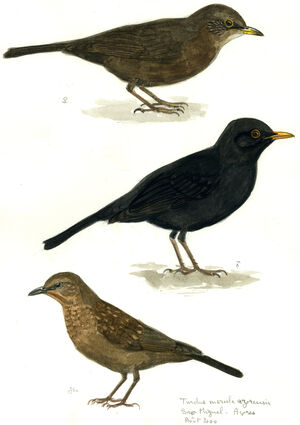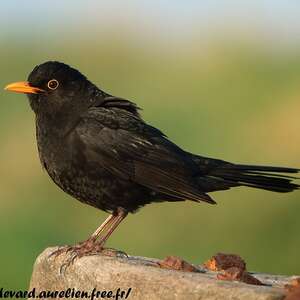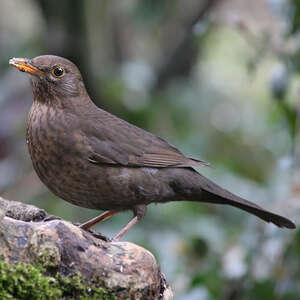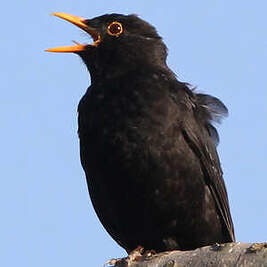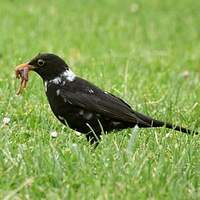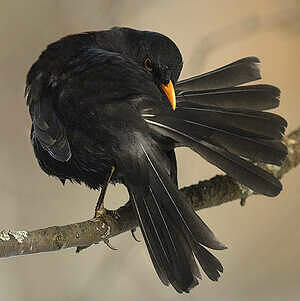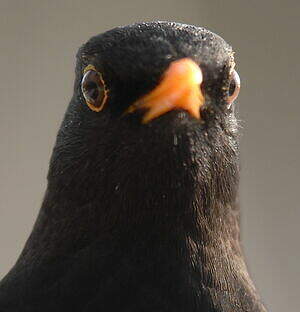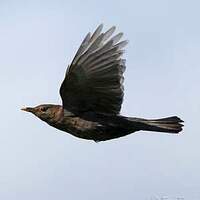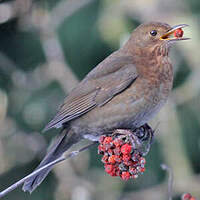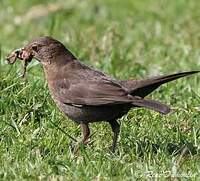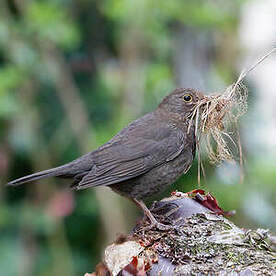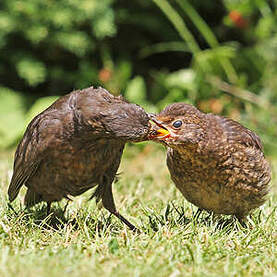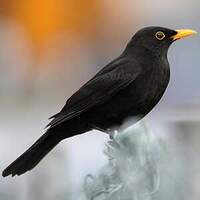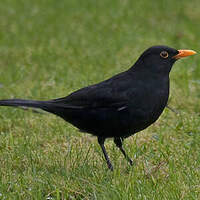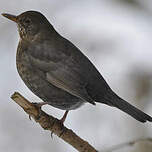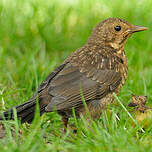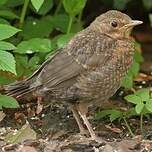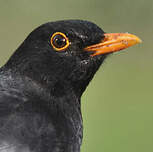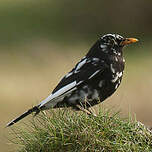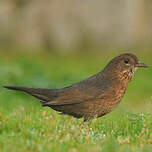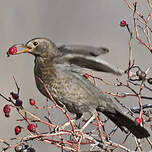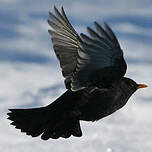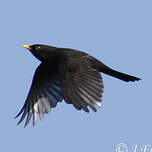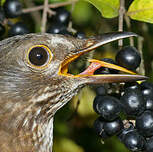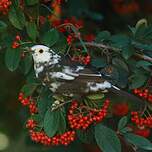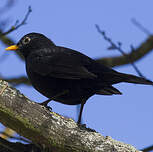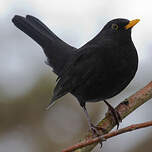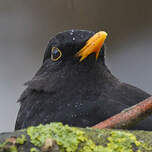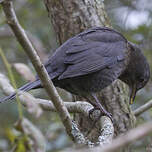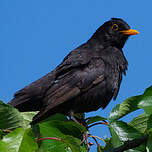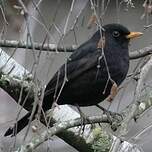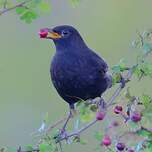Common Blackbird
Turdus merula - Merle noir
Identification
The Common Blackbird is the largest turdid in the Western Palearctic domain. Its typical silhouette (long tail and short wings), its large size and its very dark plumage make it a remarkable bird, especially since it doesn't fear Humans. There is a rather pronounced sexual dimorphism. The adult male in nuptial plumage is entirely dark and uniform. Its bill is yellow-orange and its eye is surrounded by a pale orange ring of the same colour. The iris is grey or brown. The legs are reddish or brownish. The female is brown with her upper parts rather dark and her lower parts quite pale with some dark speckles. There is a great inter-individual variability as to the tonality of its plumage, oftentimes shaded by chamois on its lower parts and sometimes still with juvenile traits like a russet breast with spots. The beak is brown but can gain a yellowish tint with age. The eye ring is less visible but can be as accentuated as the male's. The juvenile is dramatically different to the point one might think they were looking at a different species, a thrush for example. Its plumage is of a quite light brown, clearly tinted with russet on the face, on the throat and on the chest and fully speckled or striped with chamois above and below. The bill is lighter than the female's and the legs are rosy. Cases of leucism are frequent among this species, probably due to consanguinity in some populations, urban ones for instance. Leucism is characterised by white feathers in the midst of the black plumage and varies in its intensity. The disposition of the white speckles appears random and in extreme cases the Common Blackbird may be mostly white. It is a genetic anomaly that prevents the synthesis of black pigment, melanin.
Subspecific information 7 subspecies
- Turdus merula merula (Europe. except se.)
- Turdus merula azorensis (Azores)
- Turdus merula cabrerae (Madeira and Canary Is.)
- Turdus merula mauritanicus (nw Africa)
- Turdus merula aterrimus (se Europe, Turkey, the Caucasus and n Iran)
- Turdus merula syriacus (islands of s Greece, s Turkey to s Iran, n Iraq and Egypt)
- Turdus merula intermedius (mountains of c Asia to n Afghanistan)
Foreign names
- Merle noir,
- Mirlo común,
- melro-preto,
- Amsel,
- fekete rigó,
- Merel,
- Merlo,
- koltrast,
- Svarttrost,
- drozd čierny,
- kos černý,
- Solsort,
- mustarastas,
- merla,
- Svartþröstur,
- kos,
- melnais meža strazds,
- kos,
- Чёрный дрозд,
- ニシクロウタドリ,
- 欧乌鸫,
- 烏鶇,
Voice song and cries
The alarm call of the Common Blackbird, which it utters when disturbed, is a loud tjuk, repeated 5 or 6 times, and whose rhythm can accelerate while growing crescendo, in a somewhat frantic phrase when it is very anxious. This same call can take on a very metallic tone tjink tjink tjink. It is the cry that males in territorial areas make at dusk. Another classic cry, a very shrill and vibrated siiiih, is used as a territorial or warning cry in presence of danger. A close cry, a loud srrri, is emitted in flight. Young ones away from the nest manifest their presence and beg with hurried djrr djih djih djah. The song, sung from a exposed perch, is a long melodic phrase made of clear and sonorous notes, uttered with a rather slow rhythm. The song includes more whistled syllables, sometimes somewhat discordant. Its variability is great. Each male has its own repertoire and can be easily identified by its song.
Habitat
The Common Blackbird is a forest species which, due to its ecological plasticity, is capable of occupying virtually all arboreal habitats, ranging from deep forests to the heart of big cities.
Behaviour character trait
The Common Blackbird's usual posture is quite upright, with its tail in line with its body. When on the ground, foraging for food, it adopts a more horizontal attitude. Perched and alert, it raises its tail and drops its wings, sprinkling the air with its distinctive "tik" sound. The male singing bird, head held high, lets its tail fall vertically. The Common Blackbird is a territorial bird during the breeding season. It becomes more sociable in between breeding seasons, but never forms organized groups like its relatives the thrushes do. Even when migrating, it will do so on its own or in loose, small groups.
The species is generally quite abundant, so its density in favourable areas like urban parks can be quite high, leaving small, contiguous territory sizes. All year round, the blackbird feeds on the ground, hopping around small distances and using its beak to fling away leaves and other detritus to uncover animal prey underneath. It counts earthworms as a major part of its diet, including any anecic earthworms that hide in vertical galleries in the soil. This becomes a race between the worm and the blackbird and it is rather amusing to watch a blackbird trying to yank away a worm already in its burrow, resisting with all its strength. More often than not it ends with the worm breaking in half. As the season advances and ripe fruits become available on trees and bushes, it turns to them, displaying its agility in the foliage. In this regard, its long tail and short wings can be seen as adaptations for an arboreal life. When breeding season rolls around, territoriality takes over. This is followed by male to male combat and pursuits, vocal jousts from prominent perches, occasional beak grappling and, more rarely, body to body combat.He loves sunbathing and to do so he lies on the ground, feathers puffed, tail and wings stretched out, crown raised and beak open, taking in as much of the sun's rays as possible on his skin. All birds do this, but he doesn't hide while he does it.Flight
Dietfeeding habits
The Common Blackbird has a mixed diet. It is a very varied predator of invertebrates. Depending on the season and the humidity of the soil, it can either be drawn towards earthworms, of which it is a great consumer, especially at the time of raising the young, or towards insects and their larvae, in particular lepidoptera.
In the warm season, as soon as the soil dries a little but the fruits appear, it becomes very frugivorous. It appreciates the cherries of the orchards, figs, blackberries,... Frugivore, it remains so in winter when the soil is frozen or covered with snow and it exploits the fruits of the hawthorn, buckthorn, rosebushes, prickly pears and other cotoneasters.Reproduction nesting
The Common Blackbird nests in thick woody shrubs, both deciduous and evergreen, such as those found in hedgerows, groves, parks and gardens, wood margins and clearings, etc.
The sedentary birds start their reproduction early, at the end of winter. If they do not have shrubs suitable for sheltering the nest, since the foliage is not yet developed, they settle for substitute sites such as ivy along a trunk or a wall, a pile of branches in the forest, or even more unusual sites such as a tuft of grass on the ground or a beam under a roof overhang. The pair is monogamous, but with a high rate of infidelity. The nest, a large and rather loose cup, is built at very variable heights (0.5 - 15 m), often well hidden. It is made of dry grass, leaves, twigs, moss, fibres and roots, all coated with mud on the inside. Occasionally, heterogeneous materials can be included, pieces of paper or plastic, pieces of string, or other. The inside surface of the cup is smoothed with mud and is therefore very dark. The presence of dry mud makes the nest quite durable, at least enough to host a second brood, or even a third. The female lays 3 - 6 greenish eggs, dotted with brown-reddish. Incubation lasts about two weeks, and is done by the female. The male can replace her for a short while when she leaves the nest. The chicks are nestlings and fed by both parents with animal prey. The young leave the nest 12-13 days after birth. The parents still feed them for three weeks, and they are independent after a month. A second laying is the rule most of the time.Geographic range
The Common Blackbird is a species of the Western Palearctic. It is found from the Atlantic and some of its islands (Azores, Madeira, Canaries, occupied by two subspecies, but absent from Iceland) to the Volga in the East. To the North it is found up to the mid level of the Scandinavian Peninsula. To the South it extends into the Maghreb, Asia Minor and the Caucasus, and from there spreads into the North of Iran. 6 subspecies divide this space. The populations are sedentary or to a greater or lesser extent migratory depending on the geographical position. Only the most northerly and eastern birds are truly migratory and perform real migratory movements leading them to the South of the area, the Mediterranean basin and the North of the Persian Gulf.
Threats - protection
IUCN conservation status
concern
in the Wild
threatened
evaluated
The Common Blackbird is a common and abundant bird. It is not threatened. In anthropic environments, the predation pressure exerted by cats and corvids can be very strong. Studies have shown that the populations concerned are only maintained thanks to constant immigration.
Sources of information
- IOC World Bird List (v14.1), Gill, F and D Donsker (Eds). 2023.
Other sources of interest
 Specification sheet created on
09/07/2023 by Jean François
Specification sheet created on
09/07/2023 by Jean FrançoisTranslation by AI Oiseaux.net
published: 19-02-2017 - Updated: 30-10-2020
© 1996-2024 Oiseaux.net
- Accipitriformes
- Aegotheliformes
- Anseriformes
- Apodiformes
- Apterygiformes
- Bucerotiformes
- Caprimulgiformes
- Cariamiformes
- Casuariiformes
- Charadriiformes
- Ciconiiformes
- Coliiformes
- Columbiformes
- Coraciiformes
- Cuculiformes
- Eurypygiformes
- Falconiformes
- Galliformes
- Gaviiformes
- Gruiformes
- Leptosomiformes
- Mesitornithiformes
- Musophagiformes
- Nyctibiiformes
- Opisthocomiformes
- Otidiformes
- Passeriformes
- Pelecaniformes
- Phaethontiformes
- Phoenicopteriformes
- Piciformes
- Podargiformes
- Podicipediformes
- Procellariiformes
- Psittaciformes
- Pterocliformes
- Rheiformes
- Sphenisciformes
- Steatornithiformes
- Strigiformes
- Struthioniformes
- Suliformes
- Tinamiformes
- Trogoniformes

